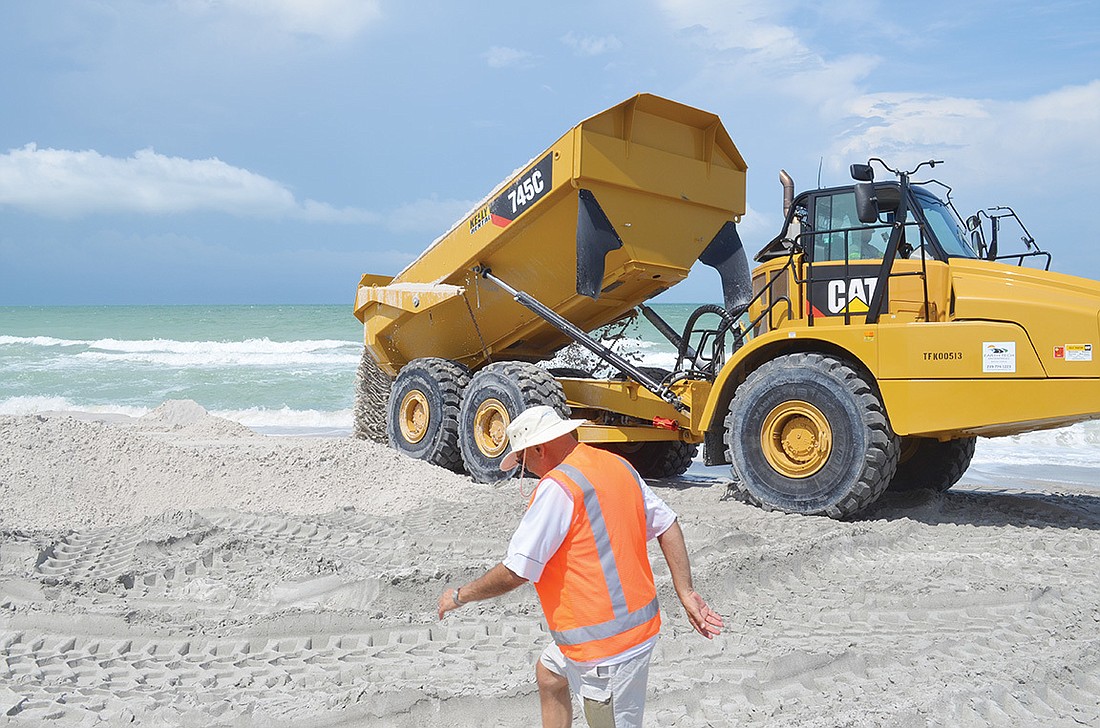- April 24, 2024
-
-
Loading

Loading

There must be a better way with beach renourishment.
Trains of dump trucks drive from inland Florida in Lee County through St. Armands Circle and up Gulf of Mexico Drive from dawn to dusk and back again six days a week. This is just one leg of an $18 million renourishment project spanning the length of Longboat Key.
And it seems odd as can be — trucking sand from the middle of the state, especially when there are tons of Longboat sand clogging New Pass. Much of that stand will be dredged and used along the Key this coming September.
To the south, Lido Key awaits a $23 million beach renourishment, the start of a 50-year plan to renourish that beach every five years.
But that one has its peculiarities, too. It is in limbo land, with the U.S. Army Corps of Engineers awaiting approval for federal money. On top of the money issue, there are still federal and state permitting labyrinths that must be conquered to begin dredging Big Pass to the south. All past experience has shown that the permitting process is slower than a momma sea turtle crawling from the gulf to the beach to lay one of its nests.
And let’s not forget, many residents of Siesta Key are not finished fighting the Corps over dredging Big Pass.
Much less controversial, but certainly no less costly, we also should mention that two years ago, the Corps of Engineers finished a $14 million renourishment project to the north — along Anna Maria Island.
Altogether, that’s $55 million in taxpayer money, some of it federal, some state, some local, going toward five municipal jurisdictions’ beach preservation efforts in a two-year period. And keep in mind: These kinds of projects have been occurring for decades independent of one other and with each one requiring each city to submit applications and go through months and months and months of state and federal environmental permitting reviews.
Invariably, these permitting processes become a game of dominoes, with one delay creating another delay, creating another problem that leads to another delay that … well, you get the picture.
These beach renourishment projects and news stories are our barrier islands’ version of Groundhog Day.
Surely, there is a better way. Especially with the permitting.
The last thing we would advocate is some overarching federal or state agency managing all beach renourishment projects around the country and Florida. Management is best at the local level.
But given that beach maintenance is an ongoing issue and requires every beachfront community in Florida to address it regularly — be it every five, six or seven years — you would think federal and state permitting processes could be devised in ways that are far, far less bureaucratic and costly than they are now.
We have advocated for years that our congressman, Rep. Vern Buchanan, intervene with the U.S. Corps of Engineers and other federal agencies involved in this process to make it more efficient.
With all of the current projects underway or attempting to get underway, now is an opportune time for the elected leaders of the barrier islands (Anna Maria, Holmes Beach, Bradenton Beach, Longboat Key, city of Sarasota and Sarasota County) to collaborate with Buchanan and state legislators to break the maddening cycle of Groundhog Day at the beach.
How government works
Three weeks ago, in a news report announcing the groundbreaking to redevelop Longboat Key’s Bayfront Park, we accompanied that story with a timeline. That was more extraordinary than the groundbreaking.
Compare it to a other timelines:
It took the U.S. three years and nine months to defeat the Germans and Japanese in World War II. Cost: estimated $4 trillion in today’s dollars.
It took the city of Sarasota and Florida Department of Transportation 10 years to bring the Ringling Bridge from public debate to completion. Cost: $65 million.
It has taken the town of Longboat Key 13 years (2003 to 2016) to go from a citizen petition calling for a community center at Bayfront Park to groundbreaking for the park’s redevelopment. Add another year before completion is expected. Estimated cost: $3.5 million.
Except in emergencies, government operates at one speed. Is this democracy, or is it bureaucracy? More the latter than the former.